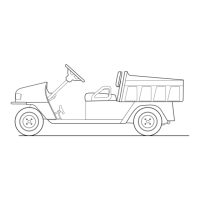D
WHEELS AND TIRES
Page D-1
Repair and Service Manual
Read all of Section B and this section before attempting any procedure. Pay particular attention to all Notes, Cautions and Warnings
WHEEL AND TIRE SERVICE
Tools List Qty. Required
Lug wrench, 3/4" ......................................................... 1
Impact wrench, 1/2" drive............................................ 1
Impact socket, 3/4", 1/2" drive..................................... 1
Torque wrench, 1/2" drive, ft. lbs................................. 1
To prevent injury caused
by a broken socket, use
only sockets designed
for impact wrench use. Never use a conventional
socket.
Tire condition should be inspected on a daily basis. Infla-
tion pressures should be checked on a weekly basis
when tires are cool. When removing wheels with an
impact wrench, use only impact sockets. Regular sockets
are not designed for impact pressures exerted by power
tools.
A tire explosion can
cause severe injury or
death. Never exceed
inflation pressure rating on tire sidewall.
To prevent tire explosion, pressurize tire with
small amount of air applied intermittently to seat
beads. Never exceed the tire manufacturer’s rec-
ommendation when seating a bead. Protect face
and eyes from escaping air when removing valve
core.
Use caution when inflating tires. Due to the low
volume of these small tires, overinflation can
occur in a matter of seconds. Overinflation could
cause the tire to separate from the wheel or cause
the tire to explode, either of which could cause
personal injury.
Use caution when inflating tires. Due to the low volume of
these small tires, overinflation can occur in a matter of
seconds. Overinflation could cause the tire to separate
from the rim or cause the tire to explode, either of which
could cause personal injury.
Tire inflation should be determined by the condition of the
terrain. See GENERAL SPECIFICATIONS section for
recommended tire inflation pressure. For outdoor appli-
cations with major use on grassy areas, the following
should be considered. On hard turf, it is desirable to have
a slightly higher inflation pressure. On very soft turf, a
lower pressure prevents tires from cutting into the turf.
For vehicles being used on paved or hard surfaces, tire
inflation pressure should be in the higher allowable
range, but under no condition should inflation pressure
be higher than recommended on tire sidewall. All four
tires should have the same pressure for optimum han-
dling characteristics. Be careful not to overinflate. Due to
the low volume of these small tires, overinflation can
occur in a matter of seconds. Be sure to install the valve
dust cap after checking or inflating.
Tire Repair
The vehicle is fitted with low pressure tubeless tires
mounted on one piece rims.
Generally, the most cost effective way to repair a flat tire
resulting from a puncture in the tread portion of the tire is
to use a commercial tire plug.
Tire plug tools and plugs are available at most
automotive parts outlets and have the advan-
tage of not requiring the tire be removed from the wheel.
If the tire is flat, remove the wheel and inflate the tire to
the maximum recommended pressure for the tire.
Immerse the tire in water to locate the leak and mark with
chalk. Insert tire plug in accordance with manufacturer’s
specifications.
If tire is to be removed or mounted, the tire changing
machine manufacturer’s recommendations must be fol-
lowed in order to minimize possibility of personal injury.
To prevent injury, be
sure mounting/demount-
ing machine is anchored
to floor. Wear OSHA approved safety equipment when
mounting/demounting tires.
Follow all instructions and safety warnings provided by
the mounting/demounting machine manufacturer.
Wheel Installation
Do not tighten lug nuts to more than 85
ft. lbs. (115 Nm) torque.
It is important to follow the ‘cross sequence’
pattern when installing lug nuts. This will
assure even seating of the wheel against the hub.
With the valve stem to the outside, mount the wheel onto
the hub with lug nuts. Finger tighten lug nuts as shown
(Ref Fig. 1 on page D-2). Then, tighten lug nuts to 50 - 85
ft. lbs. (70 - 115 Nm) torque in 20 ft. lbs. (30 Nm) incre-
ments following the same pattern.
! !
! !
! !

